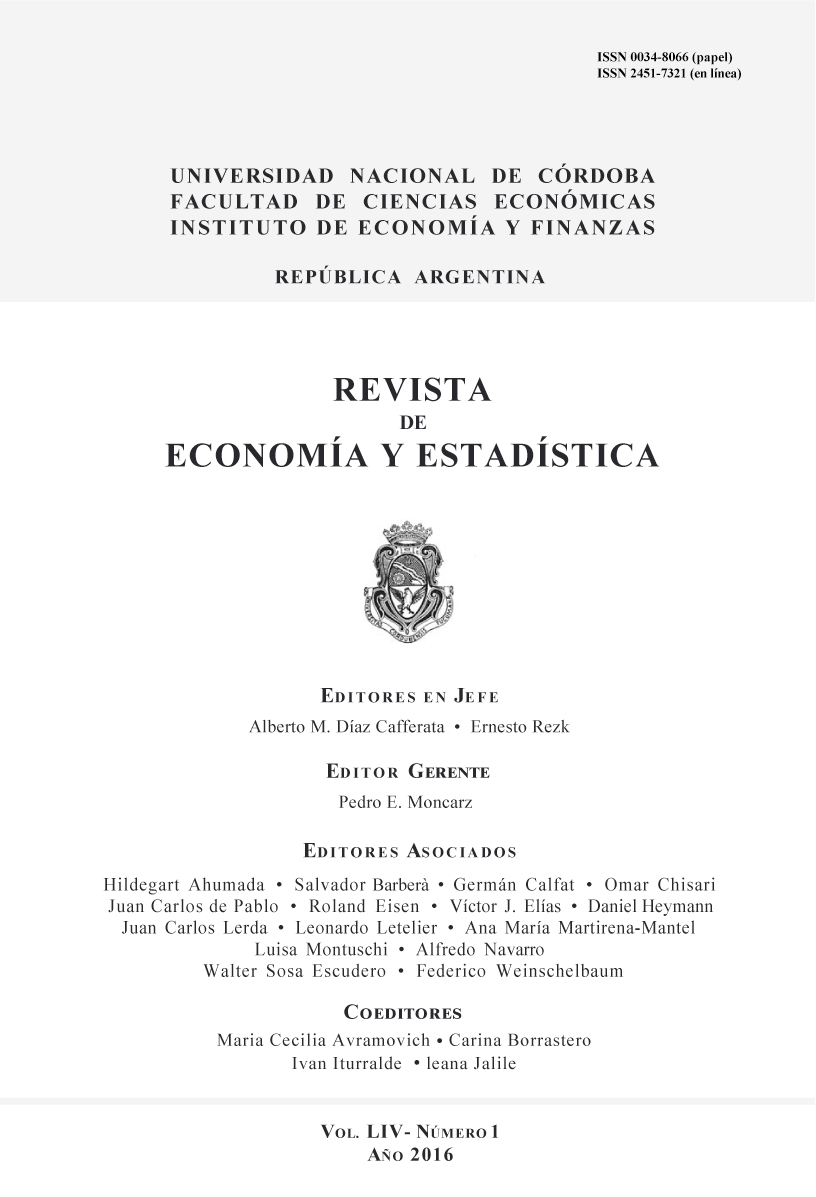The European Crisis and the Myth of the Irish Recovery: an Insight
DOI:
https://doi.org/10.55444/2451.7321.2016.v54.n1.19431Keywords:
Eurozone, banking crisis, austerity measures, interest rates, GDP, GNPAbstract
In this paper I first review the main points of the European crisis, showing that the credibility of a time-infinite fixed exchange rate, together with the free movement of capitals in the EU determined overconfidence, an excessive fall in interest rates, and overborrowing that made the system collapse when the external?originated crisis struck, damaging public finances as the banking system had to be rescued by governments. Secondly, I scrutinize an apparent success story of austerity-linked recovery from the crisis: Ireland. I outline that the outgoing government in 2010 acted well in the midst of the financial crisis, regardless of the effectiveness and desirability of the austerity measures. But I also collect facts and figures evidencing that what appears to be a true recovery is only being obtained by means of some unavoidable accounting tricks depending on a new mandatory national accounting EU rule about the treatment of investments. Unfortunately all this produces inflated figures for the GDP and GNP, while the standards of living of Irish citizens continue to fall behind.
Downloads
References
Atish G., Mahvash S. Q., Charambolos G. T. (2014). “Friedman Redux: External Adjustment and the Exchange Rate Flexibility”. No 14/146, IMF Working Papers, International Monetary Fund.
Bagnai A. (2012). Il tramonto dell’Euro. Ed. Imprimatur, November.
Barry F., FitzGerald J. (2001) “Irish Fiscal Policy in EMU and the Brussels-Dublin Controversy” in Fiscal Policy in EMU: Report of the Swedish Committee on Stabilization Policy in EMU, Stockholm. Statens Offentliga Utredningar.
Beker V. A. (2013). “The experience of three crises: the Argentine default, the American subprime meltdown, and the European debt mess”. Real-world Economics Review, issue no. 65.
Beker V. A. (2010).“ On the economic crisis and the crisis of economics”. Economics Discussion Papers 2010-18. Kiel Institute for the World Economy. Available at http://econstor.eu/bitstream/10419/36658/1/630979766.pdf
Bergin A., Fitzgerald J., Kearney I., O’Sullivan C. (2011). “The Irish Fiscal Crisis”, National Institute Economic Review, No. 217. pp. R47-R59.
Callan T., Keane C., Savage M., Walsh J. (2013).“Distributional Impact of Tax, Welfare and Public Pay Policies: Budget 2014 and Budgets 2009–2014.
Ciżkowicz P., Rzońca A., Trzeciakowski R. (2015). “Membership in the Euro Area and Fiscal Sustainability. Analysis Through Panel Fiscal Reaction Functions”. Working Papers Series 1501, Italian Association for the Study of Economic Asymmetries, Rome (Italy) . Available at http://www.asimmetrie.org/wp-content/uploads/2015/08/AISWP201501.pdf
Dunn M. (2015). “Annual national accounts - how ESA 2010 has changed the main GDP aggregates”, Eurostat - statistics explained. Available at http://ec.europa.eu/eurostat/statistics-explained/index.php/Annual_national_accounts_-_how_ESA_2010_has_changed_the_main_GDP_aggregates
Department of Environment, Heritage and Local Government of Ireland (2010). “Quarterly House Prices Bulletin”, November.
European Central Bank (2012). “Convergence Report May 2012”. Available at https://www.ecb.europa.eu/pub/pdf/conrep/cr201205en.pdf?af1f4ecc8ca30834e2c70bb04af692fa.
European Central Bank (2010). “Convergence Report”. Available at https://www.ecb.europa.eu/pub/pdf/conrep/cr201005en.pdf
European Central Bank (2003). “Policy Position of the Governing Council of the European Central Bank on Exchange Rate Issues Relating to the Acceding Countries”, December 18th.
European Commission (2014). “Convergence Report 2014”, June 4th.
European Commission (2012). “Convergence Report 2012”, May 30th.
European Commission (2012). “Specifications on the implementation of the Stability and Growth Pact, and Guidelines on the format and content of Stability and Convergence Programmes”, January 24th.
European Commission (2010). “Luxembourg Report prepared in accordance with Article 126(3) of the Treaty”, May 12th.
European Commission (2002). “Report from the Commission – Convergence Report 2002 Sweden”, May 22nd.
European Commission (1998).“European Economy n. 65 1998: Convergence Report 1998”, March.
European Monetary Institute (1995). “EMI Annual Report 1994”, April.
European Monetary Institute (1995).“Progress towards convergence”, November.
Feldstein M. (2005).“The Euro and the Stability Pact”, NBER, Working Paper 11249.
Fernandez-Villaverde J., Garicano L., Santos T. (2013). “Political Credit Cycles: The Case of the Eurozone”. NBER Working Papers 18899.
FitzGerald J. (2015) “John FitzGerald: Revised CSO figures are a dose of reality on deficit”. The Irishtimes. Available at http://www.irishtimes.com/business/economy/john-fitzgerald-revised-cso-figures-are-a-dose-of-reality-on-deficit-1.2327121, 2015.
FitzGerald J. (2014). “The Irish Recovery From the Crisis”, CESifo Forum , Vol. 15 , No. 2 , pp. 8-13.
FitzGerald J., E. Morgenroth E. (2006). “Ex Ante Evaluation of the Investment Priorities for the National Development Plan 2007-2013”, Research Series, Economic and Social Research Institute (ESRI), number PRS59.
Gianviti F., Krueger A., Pisani-Ferry J., Sapir A., Von Hagen, J. (2010). “A European Mechanism for Sovereign Debt Crisis Resolution: A Proposal. Bruegel. Available at: http://aei.pitt.edu/15123/1/101109_BP_Debt_resolution_BP_clean_01.pdf
Hennigan M. (2015). “Fact and Fiction: Time to review Ireland’s Economic Statistics?”. Finfacts. Available at http://www.finfacts.ie/irishfinancenews/article_1028946.shtml
IMF (2013). “Ireland: Ninth Review Under the Extended Arrangements”. Country Report No. 13/93. Available at: http://www.imf.org/external/pubs/ft/scr/2013/cr1393.pdf.
Irish Central Bank (2013). “Residential Mortgage Arrears and Repossesions Statistics” Information Release. Available at: https://www.centralbank.ie/statistics/data-and-analysis/credit-and-banking-statistics/mortgage-arrears/previous-statistical-releases.
Kelly M. (2009). “The Irish Credit Bubble”, Working paper series WP09/32 , Dublin: UCD Centre for Economic Research
Keynes J. M. (2015). The economic consequences of Mr. Churchill. London : L. and V. Woolf at the Hogarth Press.
Krugman P.R. (2009). The Return of Depression Economics and the Crisis of 2008. W. W. Norton, New York.
Maître B., Russell H., Whelan C. (2014). “Trends in Economic Stress and the Great Recession in Ireland An Analysis of the CSO Survey on Income and Living Conditions (SILC)”, Department of Social Protection of Ireland.
O’Connell P.J. (2012). “Cautious adjustment in a context of economic collapse: The public sector in the Irish crises”, in Vaughan-Whitehead, D. (ed.) The Public Sector Shock: The Impact Of Policy Retrenchment In Europe, Geneva: International Labour Office.
O’Leary J. (2010). “External Surveillance of Irish Fiscal Policy During the Boom”, Irish Economy Note No. 11. Available at: http://www.irisheconomy.ie/Notes/IrishEconomyNote11.pdf
Pérez-Caldentey E., Vernengo M. (2012). “The Euro Imbalances and Financial Deregulation: A Post-Keynesian Interpretation of the European Debt Crisis.” Levy Economics Institute of Bard College Working Paper No. 702. Available at http://www.levyinstitute.org/pubs/wp_702.pdf
Rajan R. (2005). “Has Financial Development Made the World Riskier?” NBER, Working Paper 11728.
Reinhart, C.M., Rogoff K. S. (2004). “Serial Default and the ̈Paradox ̈ of Rich to Poor Capital Flows.” National Bureau of Economic Research. Working Paper 10296. Available at http://www.nber.org/papers/w10296
Reinhart, C. M., Rogoff. K. S. (2008a) “Banking Crises: An Equal Opportunity Menace”. National Bureau of Economic Research Working Paper 14587. Available at http://www.nber.org/papers/w14587
Reinhart, C. M., Rogoff K. S. (2008b). “This Time is Different: A Panoramic View of Eight Centuries of Financial Crises.” NBER Working Paper No. 13882. Available at http://www.nber.org/papers/w13882.pdf
Russell H., Watson D., McGinnity F. (2013). “Unemployment and subjective well-being”, in Gallie,D. (ed). Economic Crisis, Quality of Work and Social Integration: The European Experience, Oxford: Oxford University Press.
Russell H., Maître B., Donnelly N. (2011). “Financial Exclusion and Over-Indebtedness in Irish Households”, Dublin: Department of Community Equality and Gaeltacht Affairs and Economic and Social Research Institute.
Sapir J. (2012). “Le coût du fédéralisme dans la zone Euro”. Available at http://russeurope.hypotheses.org/453
Shiller R. J. (2000). Irrational Exuberance. Princeton University Press.
Tornell A., Velasco A. (2005). “Fixed versus Flexible Exchange Rates: Which Provides More Fiscal Discipline?” NBER, Working Paper 5108, Available at http://www.nber.org/papers/w5108.pdf
Watson D., Maître B. (2013). “Social Transfers and Poverty Alleviation in Ireland: an Analysis ofthe Survey of Income and Living Conditions 2004–2011”, Dublin: Economic and Social Research Institute and Department of Social Protection.
Downloads
Published
How to Cite
Issue
Section
License
Copyright (c) 2016 Marco Biagetti

This work is licensed under a Creative Commons Attribution-NonCommercial-NoDerivatives 4.0 International License.
Authors who have publications with this journal agree to the following terms:
Authors retain their copyright and grant the journal the right of first publication of their work, which is simultaneously subject to the Creative Commons Attribution-NonCommercial-NoDerivatives 4.0 International License that allows third parties to share the work provided that its author and first publication in this journal are indicated.
Authors may adopt other non-exclusive licensing arrangements for distribution of the published version of the work (e.g. depositing it in an institutional telematic archive or publishing it in a monographic volume) as long as the initial publication in this journal is indicated.
Authors are allowed and encouraged to disseminate their work via the Internet (e.g. in institutional telematic archives or on their website) before and during the submission process, which can lead to interesting exchanges and increase citations of the published work. (See The Open Access Effect)









